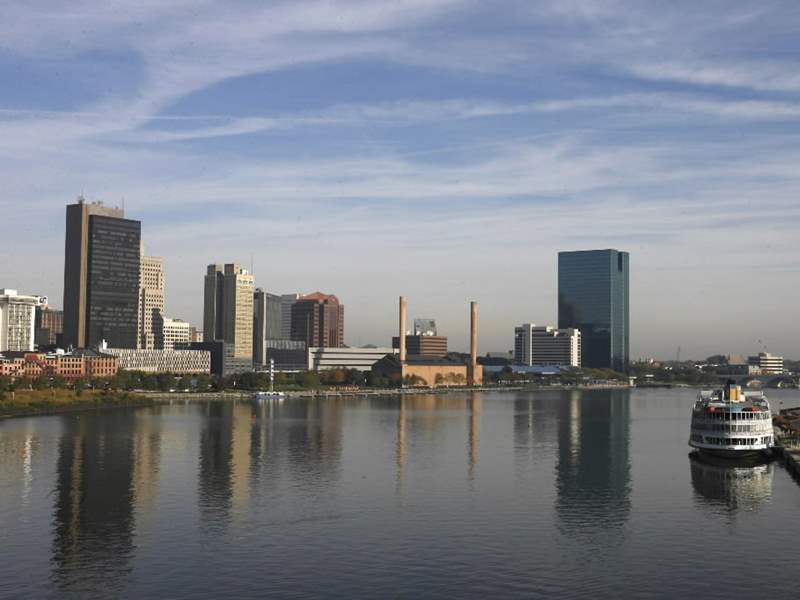
CENSUS BUREAU REPORT
Toledo again loses population, but more slowly
City down 989; some suburbs up
5/22/2014

Toledo again lost people last year, however the rate of population decline was slowing, new estimates from the U.S. Census Bureau show.
The estimates showed the city with 282,313 residents, a drop of 989 people or less than 0.4 percent from the 2012 estimate of 283,302, and 1.6 percent below the official 2010 Census of 287,017.
Toledo Mayor D. Michael Collins on Wednesday said he was braced to hear about another population decline.
“Toledo is no different than most legacy cities in America,” Mayor Collins said “My challenge as the mayor is to reverse this trend. I believe Toledo is on the threshold of change and opportunity. In my opinion, if we miss this opportunity we will continue in this urban death spiral.”
He acknowledged the city has challenges in attracting and retaining people including “fixing neighborhoods” by repairing infrastructure and blight conditions and beefing up code enforcement.
The Census Bureau released its 2013 population estimates for cities and towns across the country at midnight Wednesday. Figures are based on estimates from April 1, 2012, to July 1, 2013.
The annual estimates showed anemic growth for most of Toledo’s suburbs with only two such cities — Maumee and Oregon — losing residents.
The city of Sylvania was estimated to have 18,935 people, up 36 from the year before. Maumee’s population fell 28 people to 14,104 in the same period.
Whitehouse in western Lucas County had the biggest population jump. The village grew by 68 people, from 4,277 to 4,345.
Ottawa Hills, Waterville, and Holland had slight increases, and Berkey’s estimated population of 235 was unchanged, and only two less than what it was in 2010.
In Wood County, the report put Perrysburg as having 21,377 residents in 2013, up 172 from the year before. Bowling Green, the county’s largest city with 31,802, lost 47 people.
Oregon Administrator Mike Beazley said the overall population in the metro Toledo region has remained flat for about 40 years — as people moved from Toledo to the suburbs and birth rates declined.
“Most of us who follow census and demographic information try not to get too worked up about the annual estimates,” Mr. Beazley said. “They are frequently not accurate measures of what is going on, but there is a general consensus that the trends they identify are correct.”
Oregon has remained relatively flat in population for the last five years. The 2013 estimate for the city’s population was 20,233, six fewer people than in 2012.
“Generally the suburbs around Toledo are flat or growing,” Mr. Beazley said. “Oregon has been attractive with new home building, but like most communities, we end up with fewer children per household.”
In Michigan, the city of Monroe, at 20,405 residents, had 109 fewer people in 2013, according to estimates.
David Gedeon, transportation project manager for the Toledo Metropolitan Area Council of Governments, said estimates showing a slowdown in population declines may mean an improved economy is in the future.
“Hopefully that indicates the economy has picked up and we are beginning to retain people in the city because of job retention,” he said.
Columbus, on the other hand, has experienced a home construction boom and population growth, and with 822,553 people, had an estimated gain of 12,450 in 2013 over 2012. It joined the top 15 cities in the county with the largest numeric increase.
In Ohio’s other large cities, Cleveland’s population fell from 391,294 to 390,113, and Cincinnati reached 297,517, adding 732 more people from the year before.
Statewide, Ohio added 17,777, increasing its population to 11,570,808. Michigan also had a jump in population. The state went from 9,882,519 to 9,895,622.
The bureau said that seven of the fastest-growing U.S. cities were in Texas. San Marcos, between Austin and San Antonio, grew 8 percent between 2012 and 2013, and led the growth rate among cities with at least 50,000.
Other cities in the top 15 were Frisco, Cedar Park, Georgetown, Odessa, McKinney, and Pearland, all in Texas. Utah, Arizona, Maryland, South Carolina, Idaho, and Tennessee each had at least one city on the list.
Contact Mark Reiter at: markreiter@theblade.com or 419-724-6199.
Contact Ignazio Messina at: imessina@theblade.com or 419-724-6171 or on Twitter @IgnazioMessina.